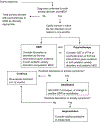Comorbid Anxiety and Depressive Symptoms in Children and Adolescents: A Systematic Review and Analysis
- PMID: 27138077
- PMCID: PMC6267783
- DOI: 10.1097/PRA.0000000000000132
Comorbid Anxiety and Depressive Symptoms in Children and Adolescents: A Systematic Review and Analysis
Abstract
Background: A large and extensive body of research has examined comorbid anxiety and depression in adults. Children and adolescents also frequently present with comorbid anxiety and depression; however, research and treatment require unique environmental and neurodevelopmental considerations in children. As a result, our understanding of comorbid anxiety and depression in children and adolescents is limited.
Objective: The goal of this systematic review was to examine the current literature focused on comorbid anxiety and depression in children and adolescents. The review included theoretical conceptualizations as well as diagnostic, neurobiological, prevention, and treatment considerations. In addition, a proposed algorithm for the treatment of comorbid anxiety and depression in children/adolescents is provided.
Methods: This systematic literature review included 3 discrete searches in Ovid SP Medline, PsycInfo, and PubMed.
Results: The review included and synthesized 115 articles published between 1987 and 2015. The available evidence suggests that anxiety and depression are common in clinical populations of children and adolescents, and that comorbidity is likely underestimated in children and adolescents. Children and adolescents with comorbid anxiety and depression have unique presentations, greater symptom severity, and treatment resistance compared with those who have either disease in isolation. A dimensional approach may be necessary for the future development of diagnostic strategies and treatments for this population. Nascent neuroimaging work suggests that anxiety and depression each represents a distinct neurobiological phenotype.
Conclusions: The literature that is currently available suggests that comorbid anxiety and depression is a common presentation in children and adolescents. This diagnostic picture underscores the importance of comprehensive dimensional assessments and multimodal evidence-based approaches given the high disease severity. Future research on the neurobiology and the treatment of these common clinical conditions is warranted.
Figures

Similar articles
-
Psychological therapies for the management of chronic and recurrent pain in children and adolescents.Cochrane Database Syst Rev. 2018 Sep 29;9(9):CD003968. doi: 10.1002/14651858.CD003968.pub5. Cochrane Database Syst Rev. 2018. PMID: 30270423 Free PMC article.
-
New generation antidepressants for depression in children and adolescents: a network meta-analysis.Cochrane Database Syst Rev. 2021 May 24;5(5):CD013674. doi: 10.1002/14651858.CD013674.pub2. Cochrane Database Syst Rev. 2021. PMID: 34029378 Free PMC article.
-
E-Health interventions for anxiety and depression in children and adolescents with long-term physical conditions.Cochrane Database Syst Rev. 2018 Aug 15;8(8):CD012489. doi: 10.1002/14651858.CD012489.pub2. Cochrane Database Syst Rev. 2018. PMID: 30110718 Free PMC article.
-
Education support services for improving school engagement and academic performance of children and adolescents with a chronic health condition.Cochrane Database Syst Rev. 2023 Feb 8;2(2):CD011538. doi: 10.1002/14651858.CD011538.pub2. Cochrane Database Syst Rev. 2023. PMID: 36752365 Free PMC article.
-
Psychological and/or educational interventions for the prevention of depression in children and adolescents.Cochrane Database Syst Rev. 2004;(1):CD003380. doi: 10.1002/14651858.CD003380.pub2. Cochrane Database Syst Rev. 2004. Update in: Cochrane Database Syst Rev. 2011 Dec 07;(12):CD003380. doi: 10.1002/14651858.CD003380.pub3. PMID: 14974014 Updated.
Cited by
-
Preliminary examination of reliability and validity of the Japanese child anxiety impact scale-parent version in Japanese community sample.Curr Psychol. 2021 Oct 31:1-10. doi: 10.1007/s12144-021-02437-5. Online ahead of print. Curr Psychol. 2021. PMID: 34744404 Free PMC article.
-
The proportion and associated factors of anxiety in Chinese adolescents with depression during the COVID-19 outbreak.J Affect Disord. 2021 Apr 1;284:114-119. doi: 10.1016/j.jad.2021.02.020. Epub 2021 Feb 8. J Affect Disord. 2021. PMID: 33592429 Free PMC article.
-
Longitudinal study of peer victimization, social support, and mental health during early adolescence.Psychol Med. 2024 Jul;54(9):1940-1955. doi: 10.1017/S0033291724000035. Epub 2024 Feb 5. Psychol Med. 2024. PMID: 38314519 Free PMC article.
-
Depression and anxiety in childhood-onset systemic lupus erythematosus: prevalence, associated factors, and impact on quality of life and family.Pediatr Rheumatol Online J. 2025 Feb 11;23(1):15. doi: 10.1186/s12969-025-01067-6. Pediatr Rheumatol Online J. 2025. PMID: 39934934 Free PMC article.
-
Analysis of Chronic Mild Stress-Induced Hypothalamic Proteome: Identification of Protein Dysregulations Associated With Vulnerability and Resiliency to Depression or Anxiety.Front Mol Neurosci. 2021 Mar 2;14:633398. doi: 10.3389/fnmol.2021.633398. eCollection 2021. Front Mol Neurosci. 2021. PMID: 33737865 Free PMC article.
References
-
- Coryell W, Endicott J, Winokur G. Anxiety syndromes as epiphenomena of primary major depression: outcome and familial psychopathology. Am J Psychiatry. 1992;149:100–107. - PubMed
-
- Rhode P, Lewinsohn PM, Seeley JR. Comorbidity of unipolar depression: II. J Abnorm Psychol. 1991;100:214–222. - PubMed
-
- Angold A, Costello EJ. Depressive comorbidity in children and adolescents: empirical, theoretical, and methodological issues. Am J Psychiatry. 1993;150:1779–1791. - PubMed
-
- Biederman J, Faraone S, Mick E. Psychiatric comorbidity among referred juveniles with major depression: fact or artifact? Am J Psychiatry. 1995;34:579–590. - PubMed
-
- Keller MB, Lavori PW, Wunder J. Chronic course of anxiety disorders in chilsdren and adolescents. J Am Acad Child Adolesc Pyschiatry. 1992;31:595–599. - PubMed
Publication types
MeSH terms
Grants and funding
LinkOut - more resources
Full Text Sources
Other Literature Sources
Medical
Research Materials

